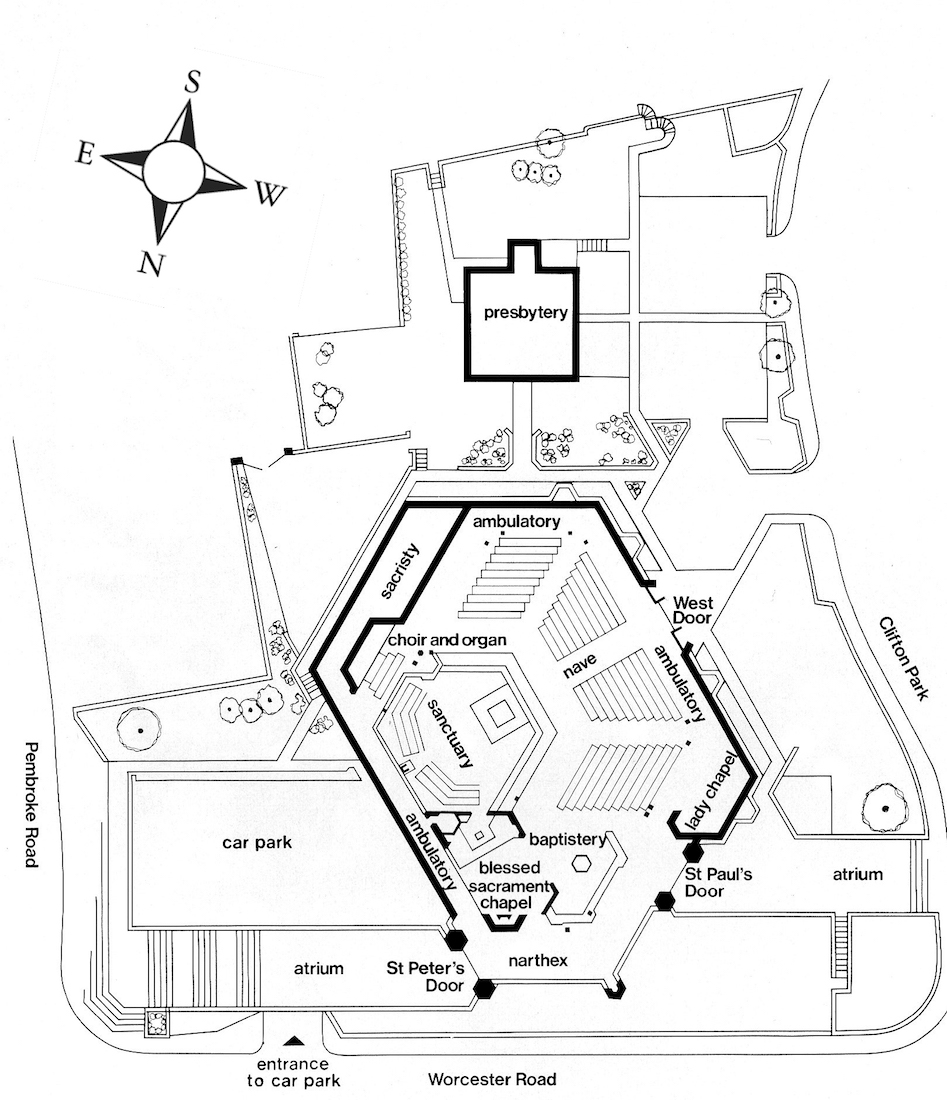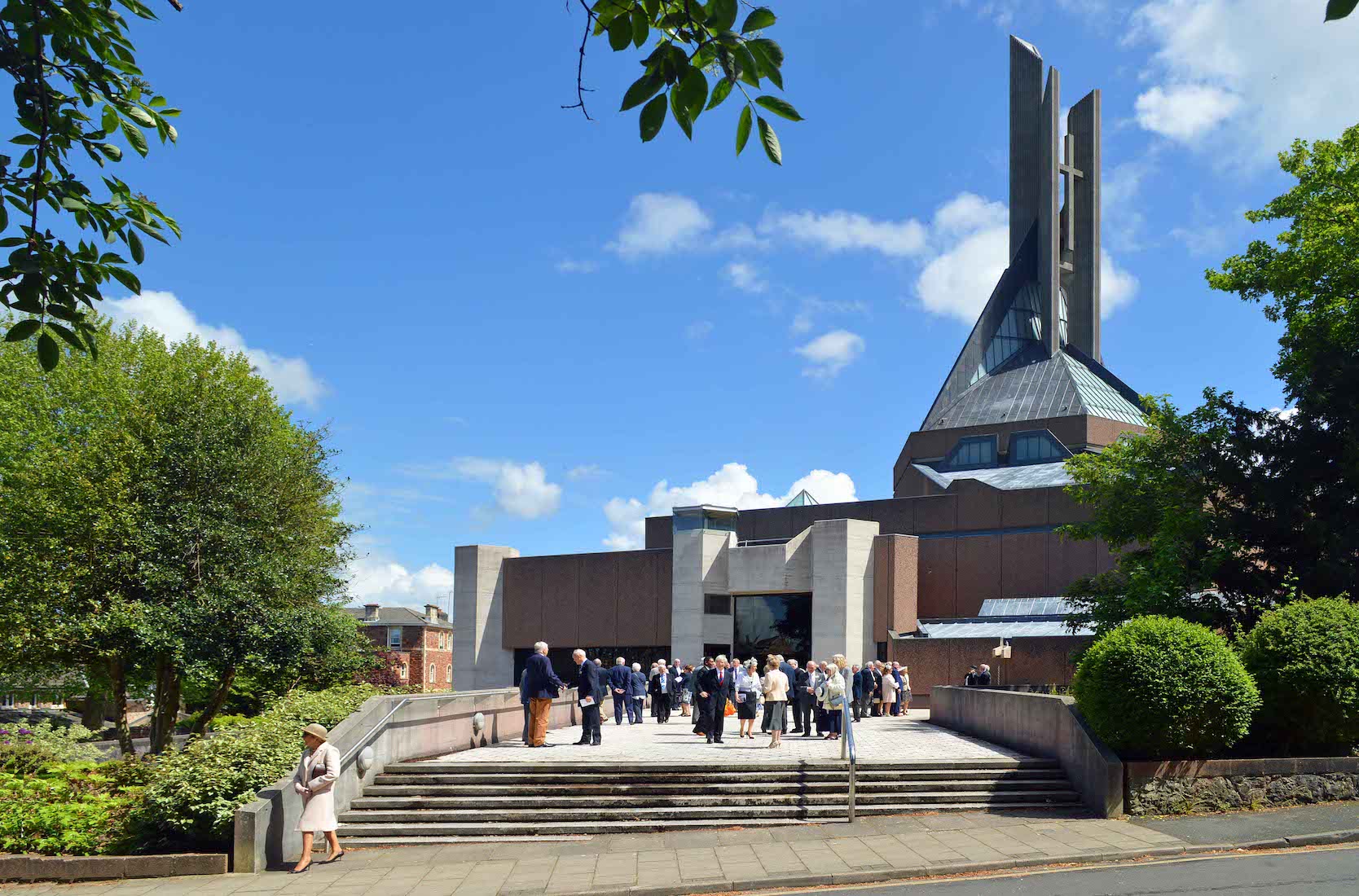CLIFTON CATHEDRAL
BRISTOL, ENGLAND CATHOLIC
PAUL SCOTT

This is the official plan of Clifton Cathedral. Notice that it needs to be rotated considerabaly to bring it into line with a normal NSEW compass setting. The Cathedral has an unusual hexagonal shape, and perhaps the best guides for orientation are the three doors with their easily recognized white concrete atria.
We shall try to circumnavigate this Cathedral in a clockwise direction starting from St Paul’s Door. However, I had problems escaping from the carpark at left, so resumed my walk near the presbytery. Coming inside, we begin our exploration at the West Door. This is a very interesting and unusual Cathedral!
A brief history of the Cathedral is given below. However, if you want to begin your tour of the Cathedral immediately, tap / click on START . You can also access intermediate points in the tour by a tap / click on the following links:
30. Chapel of the Blessed Sacrament
NOTE ON MAGNIFYING IMAGES
With this website format the images are large enough for most purposes. If there is a need for greater magnification of an image, go to the identical photo on
https://www.flickr.com/photos/paulscottinfo/albums
and use Command - + (Mac) or Windows - + (Windows).
HISTORY
[Wikipedia]
The Cathedral Church of SS Peter and Paul is the Roman Catholic cathedral of the city of Bristol (not to be confused with the Church of England Bristol Cathedral). Located in the Clifton area of the city, it is the seat and mother church of the Diocese of Clifton and is known as Clifton Cathedral. It has been a Grade II* Listed Building since 2000. It was the first Cathedral built under new guidelines arising from the Second Vatican Council.
Pro-Cathedral of the Holy Apostles
Prior to the Roman Catholic Relief Act of 1791, Roman Catholics in Britain were banned from having public places of worship, and simply being a Catholic priest or running a Catholic school was liable to punishment with life imprisonment. By the time of Catholic Emancipation, and the passing of the Roman Catholic Relief Act 1829, Roman Catholics in Bristol had established a number of local places of worship, some of them in private houses, and in Clifton by the discrete purchase, through a third party, of a plot of land known as ‘Stoney Fields’ in what is now Park Place, Clifton. In 1834, the construction of a church began there, but it was built on a challenging hillside site and had a history of problematic construction work, making work there difficult. Building stopped in 1835, started again in 1843, stopped shortly after and then the building lay abandoned until 1848 when a roof was placed on the half-completed building so that it could be used as a church. Two years later, in 1850, Clifton was made an episcopal see and the church became the Pro-Cathedral of the Holy Apostles (1850-1973), intended to act in this capacity until a more fitting cathedral church could be constructed.
Move to Clifton Park
The people of the Pro-Cathedral parish had raised some £250,000 (1970) for restoration of the Pro-Cathedral. However, with reports from the civil engineers in 1964 indicating that the Pro-Cathedral site in Park Place was unsuitable, an anonymous group of local people added to this a donation of £450,000 (1970), on the condition that a new site was found.
From 1962 to 1965 the Second Council of the Vatican met in Rome, Italy, discussing the renewal of the Church in its relationship to the world. The Council’s decree on liturgical worship focused on the role of the people, with the bishop and their priests in the celebration of the Eucharist. This was to be a strong influence in the design of the new Cathedral and, when built, the Cathedral would be the first worldwide to be designed following the new guidelines.
In 1965, architects were commissioned by the Bishop of Clifton, Rt Rev Joseph Rudderham to undertake the design of a new Cathedral on a different site in Clifton. The design was primarily by Ronald J. Weeks, working with Frederick S. Jennett and Antoni Poremba of the Percy Thomas Partnership. Although the firm had little experience in ecclesiastical architecture, Ronald Weeks had contributed a design to the competition for Liverpool Metropolitan Cathedral, and had worked on a new Catholic church in Machynlleth.
The interesting Wikipedia account continues at some length decribing the design and construction of the Cathedral, which was completed in May 1973.
https://en.wikipedia.org/wiki/Clifton_Cathedral



